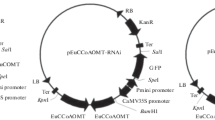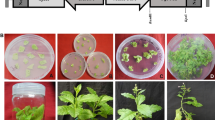Abstract
Background
In the alkaloid biosynthetic pathways of Stephania and Rannunculaceae, columbamine O-methyltransferase (CoOMT) is an important enzyme that catalyses the formation of the tetrahydropalmatin (rotundin) biosynthesis pathway. In this study, the transgenic construct pBI121-35S-CoOMT-cmyc-Kdel was designed successfully.
Methods and results
The real-time RT–PCR results proved that the CoOMT transgene was successfully introduced into Nicotiana tabacum L. plants and produced mRNA. Its transcription levels in three transgenic tobacco lines, T0-7, T0-9, and T0-20, in the T0 generation were higher than those in wild-type tobacco plants. By analysing Western blots and ELISAs, three T0 generation transgenic tobacco lines also expressed recombinant CoOMT (rCoOMT) protein with a molecular weight of approximately 40 kDa, and its contents ranged from 0.048 μg mg−1 to 0.177 μg mg−1. These data illustrated that the CoOMT transgene was expressed; thus, the rCoOMT protein synthesis efficiency increased significantly in comparison with that of the wild-type tobacco plants. The total alkaloid contents ranged from 2.12 g 100 g−1 (of dry weight) to 3.88 g 100 g−1 (of dry weight). The T0-20 plant had the highest total alkaloid content (3.88 g 100 g−1 of dry weight), followed by the T0-7 line (2.75 g 100 g−1 of dry weight). The total alkaloid contents of the CoOMT transgenic tobacco lines increased by approximately 1.09–1.83—fold compared to the wild-type tobacco plants.
Conclusions
This is the first study on the transformation and expression of the CoOMT gene in N. tabacum plants. Initial results of the analysis of transgenic plants proved that the transgenic structure pBI121- CoOMT-Cmyc-Kdel can be used for transformation into Stephania plants.




Similar content being viewed by others
References
Do TL (2006) Medicinal plants and drugs from Vietnam. Medical Publishing House, Hanoi, pp 780–781
Nguyen TH, Nguyen QH, Pham HTT, Hoang VT (2014) Taxonomy of some species in the genus Stephania Lour. in Vietnam using rADN ITS sequences. J Pharmacy 54(9):55–59
Xie DA, He JA, Huang JA, Xie HA, Wang YA, Kang YAC, Jabbour FB, Guo JA (2015) Molecular phylogeny of Chinese Stephania (Menispermaceae) and reassessment of the subgeneric and sectional classifications. Aust Syst Bot 28:246–255. https://doi.org/10.1071/SB14023
Vu TC, Nong VD, Tran VT, Xia NH (2019) Stephania polygona (Menispermaceae): a new Species from Southern Vietnam. Phytotaxa 400(3):211–214. https://doi.org/10.11646/phytotaxa.400.3.8
Cao L, Mu Z (2020) Stephania tetrandra chloroplast, complete genome. https://www.ncbi.nlm.nih.gov/nuccore/NC_050924.1. Accessed 26 May 2021
Shi Y, Liu B (2020) Stephania kwangsiensis chloroplast, complete genome. https://www.ncbi.nlm.nih.gov/nuccore/NC_048524.1. Accessed 26 May 2021
Zhang K (2021) Stephania dielsiana chloroplast, complete genome. https://www.ncbi.nlm.nih.gov/nuccore/NC_054337.1. Accessed 26 May 2021
Morishige T, Tsujita T, Yamada Y, Sato F (2000) Molecular characterization of the S-adenosyl-L-methionine: 3′-hydroxy -N-methylcoclaurine 4¢-O-methyltransferase involved in isoquinoline alkaloid biosynthesis in Coptis japonica. J Biol Chem 275:23398–23405. https://doi.org/10.1074/jbc.M002439200
Choi KB, Morishige T, Shitan N, Yazaki K, Sato F (2002) Molecular cloning and characterization of coclaurine N-methyltransferase from cultured cells of Coptis japonica. J Biol Chem 277:830–835. https://doi.org/10.1074/jbc.M106405200
Morishige T, Dubouzet E, Choi KB, Yazaki K, Sato F (2002) Molecular cloning of columbamine O-methyltransferase from cultured Coptis japonica cells. Eur J Biochem 269(22):5659–5667. https://doi.org/10.1046/j.1432-1033.2002.03275.x
Chen PY, Wang CK, Soong SC, To KY (2003) Complete sequence of the binary vector pBI121 and its application in cloning T-DNA insertion from transgenic plants. Mol Breed 11:287–293. https://doi.org/10.1023/A:1023475710642
Topping J (1998) Tobacco transformation. Methods Mol Biol 81:365–372. https://doi.org/10.1385/0-89603-385-6:365
Olhoft PM, Donovan CM, Somers DA (2006) Soybean (Glycine max) transformation using mature cotyledonary node explants. Methods Mol Biol 343:385–396. https://doi.org/10.1385/1-59745-130-4:385
Livak KJ, Schmittgen TD (2001) Analysis of relative gene expression data using real-time quantitative PCR and the 2 (-Delta Delta C(T)) method. Methods 25(4):402–408. https://doi.org/10.1006/meth.2001.1262
Gahrtz M, Conrad U (2009) Immunomodulation of plant function by in vitro selected single-chain Fv intrabodies. Methods Mol Biol 483:289–312. https://doi.org/10.1007/978-1-59745-407-0_17
Laemmli UK (1970) Cleavage of structural protein during the assembly of the head of bacteriophage T4. Nature 227:680–685. https://doi.org/10.1038/227680a0
Sun HJ, Cui ML, Ma B, Ezura H (2006) Functional expression of the tastemodifying protein, miraculin, in transgenic lettuce. FEBS Lett 580:620–626. https://doi.org/10.1016/j.febslet.2005.12.080
Nantongo JS, Odoi JB, Abigaba G, Gwali S (2018) Variability of phenolic and alkaloid content in different plant parts of Carissa edulis Vahl and Zanthoxylum chalybeum Engl. BMC Res Notes 11(1):125. https://doi.org/10.1186/s13104-018-3238-4
Liao D, Wang P, Jia C, Sun P, Qi J, Zhou L, Li X (2016) Identification and developmental expression profiling of putative alkaloid biosynthetic genes in Corydalis yanhusuo bulbs. Sci Rep 6:19460. https://doi.org/10.1038/srep19460
Lo TS, Le HD, Nguyen VTT, Chu HH, Le VS, Chu HM (2015) Overexpression of a soybean expansin gen, GmEXP1, improves drought tolerance in transgenic tobacco. Turk J Bot 39:988–995. https://doi.org/10.3906/bot-1502-40
Pham TTN, Nguyen HQ, Nguyen TNL, Dao XT, Sy DT, Le VS, Chu HM (2020) Overexpression of the GmDREB2 gene increases proline accumulation and tolerance to drought stress in soybean plants. AJCS 14(3):495–503. https://doi.org/10.21475/ajcs.20.14.03.p2173
Bui TH, Nguyen TNL, Nguyen TT, Le VS, Chu HM (2018) Expression analysis of the recombinant Catharanthus roseus deacetylvindoline 4-O-acetyl transferase in tobacco plants. Aust J Crop Sci 12(07):1139–1143. https://doi.org/10.21475/ajcs.18.12.07.PNE1077
Lo TMT, Vi TXT, Le HD, Le VS, Chu HH, Chu HM (2016) RNAi-mediated resistance to SMV and BYMV in transgenic tobacco. Crop Breed Appl Biotechnol 6:213–218. https://doi.org/10.1590/1984-70332016v16n3a32
Funding
This study was supported by the Project of Ministry of Education and Training under Grant Number B2019-TNA-09; additionally did not receive any specific grant from other public, commercial, or nonprofit funding agencies.
Author information
Authors and Affiliations
Contributions
NTTP & MHC conceived and designed the experiments; TQT, PTD, DVN performed the experiments; TQT, PTD, DVN, TTN performed data analyses; TQT, NTTP, MHC prepared the manuscript; TQT, NTTP, MHC made the proof-reading. All authors approved the final version of the manuscript.
Corresponding authors
Ethics declarations
Conflict of interest
The authors declare that there are no conflicts of interest.
Ethical approval
This article does not contain any studies with human participants or animals performed by any of the authors.
Additional information
Publisher's Note
Springer Nature remains neutral with regard to jurisdictional claims in published maps and institutional affiliations.
Rights and permissions
About this article
Cite this article
Tu, T.Q., Do, P.T., Van Nguyen, D. et al. The columbamine O-methyltransferase gene (CoOMT) is capable of increasing alkaloid content in transgenic tobacco plants. Mol Biol Rep 49, 2667–2675 (2022). https://doi.org/10.1007/s11033-021-07074-6
Received:
Accepted:
Published:
Issue Date:
DOI: https://doi.org/10.1007/s11033-021-07074-6




